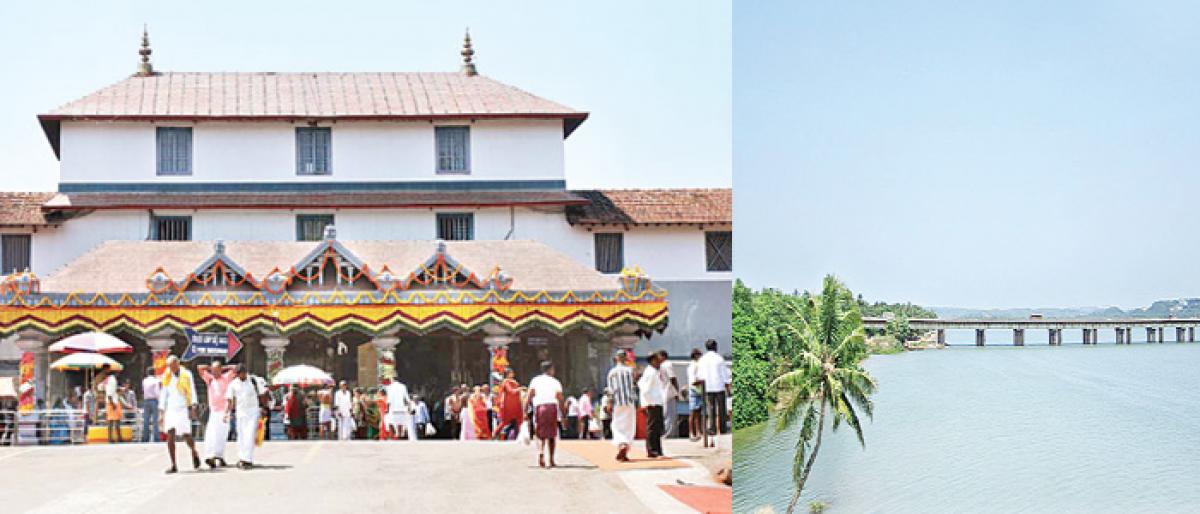Live
- Second phase randomization of EVMs is complete
- BJP confusing Matua voters though CAA notification: Mamata Banerjee
- IPL 2024: LSG might have to play the rest of the event without Mayank Yadav, says coach Justin Langer
- Two killed after colliding with a parked lorry
- PCB identifies the April 7- May 20 window for PSL 2025; to clash with IPL’s next season
- Viksit Bharat Ambassador event: Sri Sri Ravi Shankar heaps praise on PM Modi for Kashi facelift
- Women’s Hockey League: Haryana, Madhya Pradesh win on Day 5
- Indian Americans caution US university on demand to display 'flag of Kashmir'
- YS Sharmila worried over 'mental state' of brother Jagan
- PM Modi prays at Kanpur gurdwara along with CM Yogi
Just In

With trees on either side forming a beautiful canopy and at once offering glimpses of the blue skyline, the two and half hour ride from Mangalore (tea breaks included) took us to our destination. As we entered this town, rust coloured buildings with a distinct architecture, well-manicured gardens blooming with flowers of different hues and a feeling of serenity enveloped us.
With trees on either side forming a beautiful canopy and at once offering glimpses of the blue skyline, the two and half hour ride from Mangalore (tea breaks included) took us to our destination. As we entered this town, rust coloured buildings with a distinct architecture, well-manicured gardens blooming with flowers of different hues and a feeling of serenity enveloped us.
When our cabbie-cum-guide informed us that this land is known for the “Manjunatha Temple” was said to be a place where “righteousness reigned” and was therefore named “Dharmasthala” we couldn’t agree more. We drove into a lane with an imposing arch which led to the famed temple thronged by devotees who bathed in the sacred Netravathi river in the vicinity before joining the “Darshan” queue.
Announcements in Kannada requested devotees to remain silent and either meditate or focus their thoughts on Lord Shiva as the Naivedyam was offered and harathi performed. This ritual done, we proceeded to see the presiding deity Manjunatha, Ammanavaru and the guardians of dharma referred to as “Dharma Daivas”.
Interestingly, the temple which has Vaishnavite (Mardhva priests) conducting poojas is dedicated to Lord Shiva and is administered by the Jain Heggade family whose forefathers constructed the temple 800 years ago. A true bastion of religious tolerance devotees visiting the temple also pray to the huge idol of Bahubali a little distance from the temple but well within the arched entrance.
Installed in 1973 the 39ft high idol is carved out of a single stone and is one of five such Bahubali idols in Karnataka. Legend has it that the local Heggade family was visited by divine spirits (Dharma Daivas known as Kalarahu, Kalarkai, Kumaraswamy and Kanyakumari) who instructed them to construct a temple for Manjunatha. The Shivalinga in the temple is said to have been brought from Kadiri by Anappa Swamy, a vassal of the Dharmadiavas, who strangely disappeared after bringing the linga.
A temple was later built and idols consecrated by Sri Varadaraja Swami of the Udupi Mutt. 21 generations of the Heggade family of Tulu lineage have been in the service of Manjunatha as temple Dharmadhikaris (trustees).
Devotees who seek justice accept the judgement given by the “Dharmadhikari’’ the head of the Heggade family as the divine will of the deities. As we stood in the queue we witnessed the procession where the deity (Uthsavamurthi) is taken around the temple three times before we were ushered into the sanctum sanctorum.
After visiting the shrines of Manjunatha and Ammanavaru we made our way to the renowned dining hall “Annapoorna”, where devotees are served piping hot food with great love and devotion. A visit to the temple without partaking meals considered as “prasadam’’ is incomplete we are told as we make our way to the mega dining hall with immaculate arrangements.
Built in 1955 by the present Dharmadhikari Dr Veerendra Heggade’s father, the 19,800 sq ft dining hall has nine bays serving food to 25,000 – 50,000 people per day. A massive kitchen with steam boilers churns out several kilos of rice, sambar, rasam, kootu (curry) and a sweet. This menu is apparently maintained every single day.
Tables were also placed at select places for devotees who cannot sit on the floor. We were served rice from massive serving vessels wheeled in on trolleys and the rest of the items followed in quick succession.
Ladlefuls of other items and delicious buttermilk landed on our plates in a couple of minutes and we ate this “mix with great relish” marvelling at the taste and quick service. During the annual “lakshadeepam” festival in November, food is served to one lakh devotees each day according to the kitchen staff serving us.
On the last day of the festival approximately 6,500 kgs of rice and 4,500 litres of sambar are made in the temple kitchen, which has almost 25 people cutting and chopping vegetables we are told, as we stare back in amazement. Just imagining the logistics and activity that involves arrangements and works on this gigantic scale tires us.
With a massive store house, plantations growing vegetables and fruits and a dairy farm, the self-sufficient temple also encourages traditional arts and crafts. Donations in cash and kind made to the temple are put back into the massive “Annadanam” scheme as well into developing education, art and rural crafts in its vicinity.
“Many poor students have their meals here every day and are thankful for this service,” our cabbie says making his final observation on the temple. The peace that we experienced on entering the town stayed with us all through our temple visit and we returned with the wholesome experience of “Dharmasthala” firmly entrenched in our hearts.

© 2024 Hyderabad Media House Limited/The Hans India. All rights reserved. Powered by hocalwire.com







